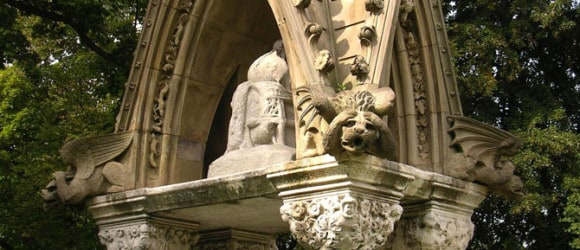The Soda Water King: A Story in Stone
- At May 04, 2013
- By Doug Keister
- In Doug Keister's Blog
 0
0

When visiting cemeteries we often seek out notable people and celebrities, but often the most interesting tombs are for people who have been largely forgotten in popular culture. Thanks to their tombs, we have an opportunity to know them better because each tomb is a story in stone. Such is the case with John Matthews’ tomb in Green-Wood Cemetery in Brooklyn, New York.
John Matthews’ monument is one of the most effervescent tombs gracing Green-Wood’s grounds. Its spectacular array of ornamentation looks like it just bubbled up out of the ground in a terra-cotta and marble ooze. And well it should bubble, for John Matthews brought soda water to America. Born in England, he apprenticed in the shop of inventor Joseph Bramah as a teenager, and learned how to make machinery, and, more importantly, learned how to make carbonic acid gas, the essential ingredient for soda water. In 1832, he left England for America, and soon set up shop at 55 Gold Street in Manhattan where he began to manufacture carbonating machinery and sell soda water to local retailers.
Matthews’ business took off when he realized he could use marble chips to make soda water, and that there was an ample supply thanks to the many construction projects taking place in the booming burg of New York. In fact, there were enough scrap marble chips from the construction of nearby St. Patrick’s Cathedral to make 25 million gallons of soda water. Matthews’ other advantage over his competitors was his rather ingenious human-safety-valve in the form of an ex-slave named Ben Austen. At the time, safety valves were unreliable, and there were frequent explosions. Ben Austen had a large and powerful thumb that he held over the pressure cock. When the pressure blew Austen’s thumb off the pressure cock, the pressure in the tank had reached the desired limit of 150 pounds and the pressurization was stopped. Austen’s thumb was so valuable that when a number of blacks were lynched during the Irish riots during the Civil War, Austen was hidden in a shipping crate to avoid detection. The term “Ben’s thumb” was part of the jargon in the soda water manufacturing industry, meaning the soda water was at the proper pressure.
John Matthews’ business continued to prosper, and he opened up numerous soda fountains, sold soda water, added flavoring to soda water, and licensed soda water apparatus. By the time he died, Matthews owned over 500 soda fountains. The Soda Water King’s final resting place is a catafalque / sarcophagus encompassed in a castrum doloris (Latin for “castle of grief”), a type of elaborate tomb usually reserved for royalty, popes, and the elite. These tombs are adorned with funerary symbols, allegorical figures, and, often, scenes from the person’s life. The Matthews tomb has the faces of his daughters carved into the gables, his wife (some accounts say it is a statue of grief) seated above him, gargoyles, and various woodland animals scampering around the edges. Prostrate and almost melting into his sarcophagus, Matthews looks up at relief panels, which depict events in his life—apprenticing at the shop in England, leaving England for America, pondering the idea of soda water, and finally being crowned for his achievements. The area around the Matthews tomb is peppered with the graves of other members of the Matthews family.
The tomb, which was crafted by Karl Muller, won an award as the Mortuary Monument of the Year soon after it was built in 1870. However, noted art critic Effie Brower had other words for it. In her 1878 book In Memoriam: Greenwood Leaves, she said that “[it reflected] the hideousness of morbid taste.”
Text and photograph © Douglas Keister Visit Doug’s Author Page.
DKeister
